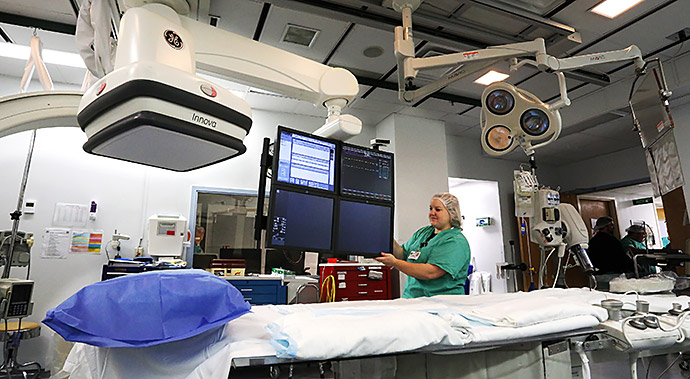
The latest technology plus caring professionals.
At Marshall Medical we've combined the latest technology with a highly trained, caring team of professionals. We offer some of the most modern cardiac catheterization technology available, including the unsurpassed GE Innova IGS 530. That's part of the first rate cardiac care that Marshall Medical Centers delivers to our community – care that’s dedicated to providing advanced cardiac cath procedures that can help you beat heart disease.
Understanding Cardiovascular Procedures
Cardiac Catheterization
Cardiac Catheterization or "Heart Cath" is a specialized study of the heart during which a catheter, or thin hollow flexible tube, is inserted into the artery of the groin or arm. Under x-ray visualization, the tip of the catheter is guided to the heart. Pressures are measured and an x-ray Angiogram (Angio) movie of the heart and blood vessels are obtained while injecting an iodinated colorless "dye" or contrast material through the catheter. Coronary angios are obtained by injecting the contrast material into the opening or mouth of a coronary artery. Coronary arteries are not visible on x-ray film. However, by filling the coronary artery with a contrast solution that blocks x-ray they can be visualized.
Find Out More - Get The Fact SheetCoronary Artery Stent
A coronary stent is an expandable metal tube. It is mounted on a balloon catheter in a collapsed state. When the balloon is inflated, the stent expands or opens up and pushes itself against the inner wall of the coronary artery. This holds the artery open when the balloon is deflated and removed. Coronary stents reestablish blood flow that relieve the recurrence of chest pain, increases the quality of life and reduces other complications.
Find Out More - Get The Fact SheetPTCA or Balloon Angioplasty
Angioplasty is a technique used to dilate an area of arterial blockage with the help of a catheter that has an inflatable small sausage-shaped balloon at its tip. The balloon catheter is introduced through the skin into the artery of the groin and sometimes the arm. This is placed within a blood vessel and advanced to the treatment area. The balloon is inflated with the objective of compressing the area of plaque against the vessel wall. This allows blood flow to be reestablished. The technique is also called PTCA or Percutaneous Transluminal Coronary Angioplasty (transluminal means in the channel or lumen of a blood vessel).
Find Out More - Get The Fact Sheet
